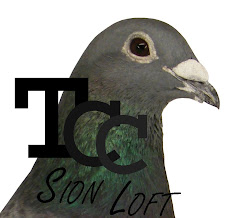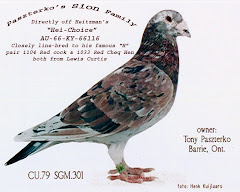The February 1933 issue of "The American Racing Pigeon News" included a 10 page paid advertisement on America's first Hall of Fame Award winner: Mr. Lewis F. Curtis. These pages included praises from leading fanciers of the day, and reprints from international racing pigeon papers.
The following article appeared on the front page of "The Messager Colombophile" on the 20th of May, 1931. This weekly publication is generally regarded as the foremost in Belgium.
"The Belgian Pigeon in America"
On June 28, 1930, a new world's record was established by six pigeons belonging to Mr. Curtis, of Massachusetts. The pigeons accomplished the trip of 600 miles, or 1000 kilometers, in 12 hours and 16 minutes, earning thus the six first places in the American Concourse for the longest distance. 51 fanciers took part in this test in which they had entered 202 pigeons.
The release of the pigeons was effected at 5:58 AM and the six victors of Mr. Curtis finished their race together by arriving at 6:14 PM at their home loft. These prize winners originated from subjects imported from Belgium and France which had been purchased directly from Messrs. Havenith, of Antwerp, Lucien Bastin, of Verviers, Guillaume Stassart, of Anderlecht, and Paul Sion, of Tourcoing. They were handled by Mr. Theodore Vekens, who is also associated with Mr. Curtis. This Belgian was highly congratulated upon this exploit and the Belgian pigeons were showered with praise.
Certain American fanciers have been known in the past to doubt the capability of our aerial racers. These parties, however, were amongst the most enthusiastic in their praise and they showed the greatest admiration for the four Continental fanciers mentioned above and, incidentally, for the Belgian pigeons to which we must, of course, add those of Mr. Paul Sion. Such a performance could not fail to arouse the highest enthusiasm on the part of American fanciers.
Thus, on January 10, 1931, the National Committee, composed of three members of the two national organizations which control the Sport in the United States, met at the Hotel Pennsylvania, in New York and unanimously accorded the first prize in the "Hall of Fame" to Mr. Curtis for the exploit performed by his six pigeons, Mr. Curtis being the first fancier in the United States to receive this high honor.
The United States War Department has had photographs taken of the official presentation of the medal which goes with this "Hall of Fame" award. All the papers of that country have done likewise and they have, moreover, published enthusiastic articles in honor of the victor and his pigeons, an honor which he owes chiefly to the Belgian pigeon fanciers who also are entitled to all the honors of this occasion. We can see that they do things in a big way over there. We can see also that the military authorities attach a great deal of importance to the great deeds performed by racing pigeons. We can see, finally, that our pigeons are more than ever gaining great honor in America.
And you, dear Mr. Curtis, please accept our best congratulations. You may be sure that we heartily hope you may be able to duplicate this exploit. Your are young. You have yet a long career before you and you have the instruments which permit one to believe that this hope may well be expected to come true. On that day you will have won a title of imperishable Glory and all the Belgian pigeon fanciers, as well as all true American sportsmen, will join in acclaiming your success.
Forward hence, to a second victory for the Belgian racing pigeon, the best in the whole world.
The following article appeared on the front page of the "Messager Colombophile" published on August 10, 1932.
"In America"
Our readers will recall the unprecedented success by Mr. Lewis F. Curtis, of Boston, Massachusetts, U.S.A., in 1930. For those who are not acquainted therewith, as for instance our new subscribers, and they are numerous, we will state again that Mr. Curtis was the victor in the great American meet at 600 miles distance. Such a distance means about 1000 kilometers.
As far as he is concerned it was a real triumph. Six of his pigeons returned together having covered the distance in 12 hours and 16 minutes which means more than 1300 metres per minute. These six prize winners, whose victory has kept an endless number of newspaper men busy writing in American and has been celebrated in great style, are of Belgian origin. Incidentally speaking, Mr. Curtis has never tried to hide this fact and has, moreover, sent us quite recently a magnificent photograph in colors of his great 600-mile champions which even aroused the particular attention of the United States military authorities at a time when the trophy was awarded which these pigeons had won in such a remarkable manner at 600 miles.
With this magnificent photograph we also received a printed table which for us Belgians is really a remarkable document as it specifies the pedigree of these prominent fliers all of which are of essentially Belgian origin. This document confirms again that the Belgian racing pigeon is the best in the entire world. This is a fact which no one can gainsay, neither Mr. Curtis, nor the Americans in general, as well as all of those who are closely connected with matters bearing on pigeon racing.
Since their unparalleled success in 1930, Mr. Lewis F. Curtis has been recording victory after victory with his Belgian pigeons.
In 1930 and 1931 he has won first place in 9 large concourse races out of 20 flown, comprising all the old bird races scheduled for that period.
During three successive years, namely - 1930, 1931, and 1932, the results realized by him at 600 miles distance have been simply the best that have been brought about in America and the entire racing world.
In 1930 his six pigeons won at 600-miles in 12 hours and 16 minutes. Then Mr. Curtis wins again the 600-mile race with one pigeon in 1931, the time being 12 hours and 42 minutes. In 1932 he establishes a new world's speed record for this distance covering the 600 miles in 9 hours and 27 minutes. At the last-named meet there were 236 pigeons belonging to 42 fanciers. The first 9 arrivals won the prizes awarded in this race. Amongst them Mr. Curtis had six. Their rating was as follows: 1st, 3rd, 5th, 6th, 7th, and 9th. After the first arrival he identifies 12 pigeons in 20 minutes owing to which he records the following results in the general classification: 1st, 3rd, 5th, 6th, 7th, 9th, 10th, 12th, 14th, 15th, 18th, 23rd, 32nd, 53rd, 61st, 62nd, 63rd, 64th, 73rd, 78th, and 90th.
A lucky pigeon fancier, all the same!
We can only wish that for a long time to come he will perpetuate the glory of the Belgian racing pigeon.
Continued








